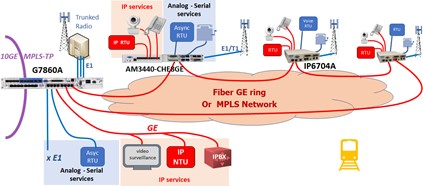TDMoE Pseudowire
TDMoE/IP/MPLS Pseudowire Technology
The emulation of TDM link over packet has been developed to transport voice networks over large Packet Switched Network (PSN) to carry not only the payload but also the TDM service-connected end to end. Initially this technology was developed for trunk, then for access to replace E1/T1 voice to PBX (or lease line), over EFM DLS or Wireless and maintaining the existing TDM CPE. These TDMoPSN applications still exist, but it has generally migrated to voice Centrex and IP/Ethernet cloud services.
But for utilities, special voice communications, and many industrial domains, some applications still use Legacy interface, analog measurements, and low-rate signal with high latency accuracy. These have yet to migrate to native packet and will certainly be used beyond the next decade. These are the scopes for TDMoPSN PseudoWire technology activities.
PSN IP/Ethernet networks cause constraints for TDMoPSN because they are elastic, unstable forms of traffic that depend on off-crossed switch or router nodes. These TDM links require high stability and low latency. To use the TDMoPSN, we must select the adapted emulation protocol to the interfaces type, the size of the packets, the buffer size to limit jitter delay and take care of the synchronization. Customers must make a compromise between small packet size with low latency requiring high bandwidth, or larger packet size with more latency and but which requires reduced bandwidth. Loop provides tools and OAM to control these parameters. The TDMoMPLS transport over LSP is easily controlled by the Traffic-Engineering engine of MPLS-TP transport.
The PseudoWire Emulation End-to-End (PW or PWE3) are used to transport Services such as TDM-PDH (E1/T1/E3/DS3), SDH/SONET (STM1/STM4, OC3/OC12), ATM, Ethernet with VLAN/Q-in-Q, SAN… over Packet Switched Network: IP, Ethernet or MPLS. Different emulations are used for unframed and framed.
Loop Telecom provides a large range of TDM PseudoWire emulation gateway for the transport from single Time Slot 64Kbps to the STM4 622Mbps over Ethernet, IP and MPLS-TP/IP transport network.
The PseudoWire Emulation Protocols use:
SAToP (Structure Agnostic TDM over Packet) according to RFC 4553. This emulation is used to transport only unframed service or clear channel interfaces E1, T1, E3, DS3. Unframed data link, as E1 G.703, is sliced according to the synchronization but without consideration of content. This simple emulation protocol is mainly used in Telco as mobile transport infrastructure.
CESoPSN (Circuit Emulation Services over Packet Switched Network) according to RFC 5086. This emulation is used to transport only framed service of n.64kbps, FE1, DS1 circuits. The customer must choose a multiple of E1 structured frames with number TS/DS0 in a CESoPSN frame. The latency is directly depending on frame size selected and the number of Time Slot (TS or DS0). The TS0 and CAS are transported as a data information in PW frame but do not use a TS to transport. This emulation protocol is used by industry, SCADA, teleprotection, for small independent circuits with few TS/DS0 dispatched to different application servers or NTUs. This application gives the possibility to groom multiple PWs in a single E1/T1 without use of additional DACS/DCS.
MEF-8 or TDMoE (Circuit Emulation Services over Ethernet) designed by MEF Metro Ethernet Forum, is like CESoPSN and supports framed service n.64kbps, E1, DS1 circuits.
CEP (SDH or SONET Circuit Emulation over Packet) RFC4842, supports the Emulation End to End of Virtual Container VC-11, VC-12, VC-3, VC-4, VC-4-4c or Synchronous Payload Envelope STS-1, STS-3c STS-12c…
The Bundle is the name of a TDM PseudoWire including both end addresses and TS number.
The frequency synchronization of both device in End-to-End is particularly important for an efficient emulation. The TDMoPSN Gateway can be synchronized internally, by external E1/T1 or over the Ethernet WAN, by the local/remote device with SyncE WAN, or by a PW with ACR (Automatic Clock Recovery).
Loop Telecom TDMoPSN Gateway can provide many solutions that can be adapted to each need of TDM transport over the Packet Network.
We can provide point to point transport of E1, T1, E3, DS3 or the concentration of these interfaces together of Ethernet traffic, the direct conversion to SDH/SONET STM1/4 or OC3/12 or the long-distance transport in MPLS-TP.
As an example, the Railway operator wants to change the telecommunication along a line and keep many legacy terminals before a full migration:
Along the railway line we will replace the old TDM mux, the BdB-Fsk-voice copper extension by Loop Telecom Gateway IP6704A or AM3440-CHE which are concentrated over GE fiber or MPLS core network to a redundant central with G7860A:
- E1/T1 PMR/GSM-R traffic are connected to central with SAT Emulation
- Each analog, as Scada E&M RTU, Magneto voice, or serial services, are connected to central with CES Emulation and groomed in E1 per service or directly to analog/serial NTU and with conference support
- All New services: IP Scada, VoIP, CCTV, etc. are locally connected or forwarded over 10GE MPLS-TP network. Step by step the migration to native packet applications can be deployed with same telecom equipment.

Loop Telecom proposes different ranges of simple TDMoEth/IP gateways or with TDM cross-connect multiplexer and a range of MPLS-TP/CE/IP transport devices with TDMoEth/IP/MPLS gateway. All devices are working together, and are manageable for hybrid circuits from/to TDM side to Packet side with gateway by the EMS iNET with assisted PW creation, or by the NMS iNMS for large network with automatic commissioning of nodes.
